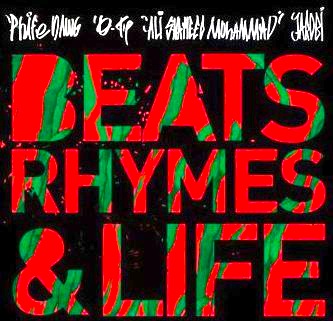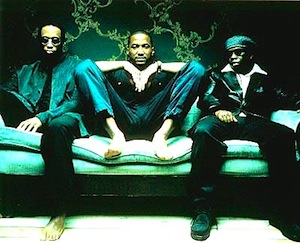 By Joe Bendel. If not necessarily the road not taken, A Tribe Called Quest definitely represents a road less traveled for hip-hop. Influenced by jazz and African musical forms whilst largely eschewing the nihilism of gangster rap in favor of a more spiritual message, ATCQ achieved a level critical acclaim unusual for hip-hop, yet still maintained their grassroots popularity. Alas, it would not last forever. Indeed, Michael Rapaport records the band’s break-up in his up-close-and-personal documentary, Beats, Rhymes & Life: The Travels of A Tribe Called Quest, which premiered at the 2011 Sundance Film Festival.
By Joe Bendel. If not necessarily the road not taken, A Tribe Called Quest definitely represents a road less traveled for hip-hop. Influenced by jazz and African musical forms whilst largely eschewing the nihilism of gangster rap in favor of a more spiritual message, ATCQ achieved a level critical acclaim unusual for hip-hop, yet still maintained their grassroots popularity. Alas, it would not last forever. Indeed, Michael Rapaport records the band’s break-up in his up-close-and-personal documentary, Beats, Rhymes & Life: The Travels of A Tribe Called Quest, which premiered at the 2011 Sundance Film Festival.
Despite sitting for many interviews and allowing backstage access to Rapaport’s crew, the very vocal Q-Tip has reportedly since turned against the project. It’s hard to understand why, though. As backstage conflict goes, ATCQ’s is pretty tame stuff. Indeed, there’s nothing Charlie Sheen-worthy to be witnessed in the film. As seen through Rapaport’s cameras, their break-up appears to be largely attributable to the stress of Phife Dog’s health issues and the inevitable resentments bred by a long period of familiarity. Frankly, as behind-the-music profiles go, BRL makes ATCQ look pretty together.

After beginning at the apparent end, Rapaport rewinds to the beginning, giving a brisk overview of the band’s history. Signed for what was then an unprecedented advance, ATCQ was under pressure to deliver from the start, but that was not a problem. The early years were glory years, both in terms of music and sales. Perhaps the group reached its artistic high-water mark when collaborating with De La Soul in the egoless super-group Native Tongue.
Throughout their tenure, ATCQ had a rep as a musician’s hip-hop group. Not surprisingly, the best moments of BRL capture a sense of the group’s grounding in jazz and soul. A committed crate-digger, Q-Tip in particular emerges as an authority on vintage soul jazz LPs, like (Dr.) Lonnie Smith’s Drive, which he famously sampled and discusses at length in the film.
While opinion amongst ATCQ seems decidedly mixed, BRL will hardly damage their legacy. It will rather more likely strengthen their reputation as the thinking man’s hip-hop group. Though a snip here or there would not have been the end of the world, the animated sequences created by James Blagden & Phillip Niemeyer and the original incidental soundtrack by Madlib tie it all together in a solid, often entertaining package. Given the band’s continuing popularity as well as Rapaport’s name recognition as an actor, it seems like a good bet there will be considerable demand for BRL following its recent Sundance premiere. Well put together and only occasionally voyeuristic, BRL was a hit at Sundance, which concluded Sunday (1/30) with special screenings of this year’s award winners.
Posted on February 1st, 2011 at 9:16am.

One thought on “LFM Sundance Review: Beats, Rhymes & Life”
Comments are closed.